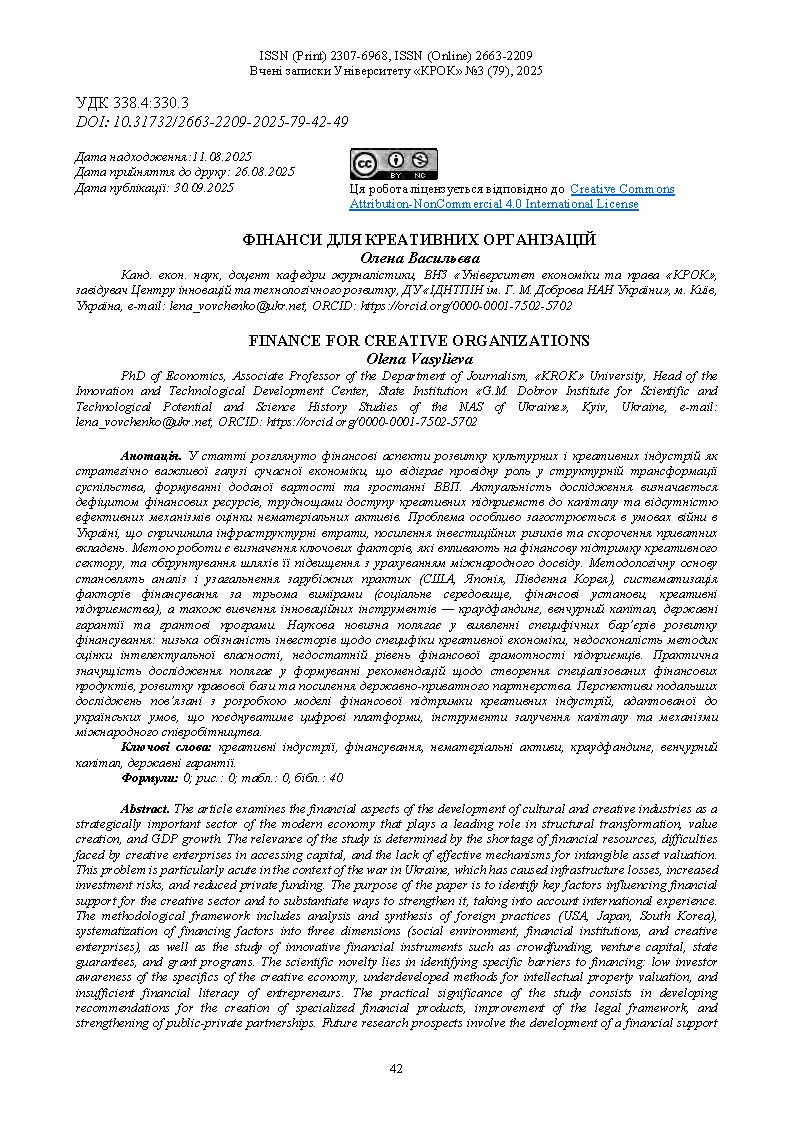FINANCE FOR CREATIVE ORGANIZATIONS
DOI:
https://doi.org/10.31732/2663-2209-2025-79-42-49Keywords:
creative industries, financing, intangible assets, crowdfunding, venture capital, state guaranteesAbstract
The article examines the financial aspects of the development of cultural and creative industries as a strategically important sector of the economy that plays a key role in structural transformation and GDP growth. The relevance of the study stems from the lack of financial support and the difficulties creative enterprises face in accessing capital, especially in the context of the war in Ukraine, which exacerbates infrastructure and investment barriers. The aim of the study is to identify the factors influencing financial support for the creative sector and to determine effective mechanisms for its enhancement. The methodological framework includes analysis and synthesis of international experience (USA, Japan, South Korea), systematization of financing factors into three dimensions (social environment, financial institutions, creative enterprises), and examination of financial innovation tools such as crowdfunding, venture capital, and state guarantees. The scientific results identify key financing barriers: absence of standardized methods for intangible asset valuation, low investor awareness of the specifics of the creative economy, and insufficient financial literacy of entrepreneurs. The study substantiates the need for the development of specialized financial products, improvement of the legal framework, and strengthening of public-private partnerships. Future research prospects involve the creation of a financial support model for creative industries adapted to Ukrainian conditions, combining capital attraction tools, digital platforms, and mechanisms for international cooperation.Downloads
References
Безугла, Л. С., Лазакович, І. І. (2024). Креативні індустрії та креативна економіка: досвід України в умовах війни. Економіка та суспільство, 63. DOI: https://doi.org/10.32782/2524-0072/2024-63-30
Звіт Платформи Культурних Зв’язків (2024). Retrieved from https://www.cultureinexternalrelations.eu/wp-content/uploads/2024/07/DGEAC-CRP-UA-Report-July-2024-UA.pdf
Румик, І., Плетенецька, С., Царенок, О. (2023). Особливості управління фінансовими ресурсами підприємств в умовах воєнного стану. Вчені записки Університету «КРОК», №4 (72), 9–19. DOI: https://doi.org/10.31732/2663-2209-2023-72-9-19
Український культурний фонд (2025). Retrieved from https://ucf.in.ua
Bakhshi, H., Siepel, J., Carmona, L., Tarr, A. (2024). Unleashing Creativity: Fixing the finance gap in the creative industries. Retrieved from https://unleash.wearecreative.uk
Caniels, C. J., & Rietzschel, E. F. (2015). Organizing Сreativity: Creativity and innovation under constraints. Creativity and Innovation Management, 24(2), 184–196. DOI: https://doi.org/10.1111/caim.12123
Creative Economy Outlook (2024). Retrieved from https://unctad.org/publication/creative-economy-outlook-2024
Creative Industries (2025). Retrieved from https://www.ifc.org/en/what-we-do/sector-expertise/creative-industries
Creative Industries Mapping Document (1998). Retrieved from https://www.gov.uk/government/publications/creative-industries-mapping-documents-1998
Cunningham, S. D., Ryan, M., Keane, M. A., Ordonez, D. (2008). Financing Creative Industries in Developing Country Contexts. Retrieved from https://www.researchgate.net/publication/27464633_Financing_Creative_Industries_in_Developing_Country_Contexts
Florida, R. (2002). The Rise of the Creative Class. Basic Books.
Hawkins, S. (2001). The Creative Economy: How People Make Money from Ideas. Penguin Books.
Hayes, A. (2024). What Is Venture Capital? Definition, Pros, Cons, and How It Works. Retrieved from https://www.investopedia.com/terms/v/venturecapital.asp
Higson, C., Rivers, O., & Deboo, M. (2007). Creative financing. Business Strategy Review, 18(4), 49–53.
Holmes, T. (1999). Localization of industry and vertical disintegration. The Review of Economics and Statistics, 81(2), 314–325.
Hottenrott, H., & Peters, B. (2012). Innovative capability and financing constraints for innovation: More money, more innovation? The Review of Economics and Statistics, 94(4), 1126–1142.
Huber, F. (2012). Do clusters really matter for innovation practices in information technology? Questioning the significance of technological knowledge spillovers. Journal of Economic Geography, 12(1), 107–126.
Keane, M. A. (2009). The Capital Complex: Beijing’s New Creative Clusters. In L. Kong & J. O’Connor (Eds.), Creative Economies, Creative Cities: Asia-European Perspectives (pp. 77–95). Springer.
Kim, K., Hong, E., & Rho, S. (2013). The study of defined buying factors affecting trust building and service performance in financial management systems. Mathematical and Computer Modelling, 58(1-2), 38–48.
Korea Creative Content Agency (2025). Retrieved from https://www.kocca.kr/en/main.do
Lam, J. (2006). Managing risk across the enterprise: hallenges and benefits. Risk management-a modern perspective. Stuart Graduate School of Business.
Liu, X. Y. (2006). Research on Risk Control Mechanism of Commercial Banks. Journal of Financial Research, 7, 78–85.
Local Employment and Economic Development Programme (2025). Retrieved from https://www.oecd.org/en/about/programmes/leed-programme.html
Lytovchenko, Y., Tomakh, V. (2023). Creative Economy: Opportunities for Rebuilding Ukraine. Науковий вісник Херсонського державного університету. Серія: Економічні науки, 48, 10-18. DOI: 10.32999/ksu2307-8030/2023-48-2
Maicon, O., Glauco, H., Andrei, A., & Henrique, R. (2018). Lessons learned from a successful industrial product service system business model: Emphasis on financial aspects. Journal of Business and Industrial Marketing, 33(3), 365–376. DOI: 10.1108/JBIM-07-2016-0147
Miska, C., Szocs, I., & Schiffinger, M. (2018). Culture’s effects on corporate sustainability practices: A multi- domain and multi-level view. Journal of World Business, 53(2), 263–279. DOI: 10.1016/j.jwb.2017.12.001
Mollick, E. (2013). The dynamics of crowdfunding: An exploratory study. Journal of Business Venturing, 29 (1), 1-16. DOI: https://doi.org/10.1016/j.jbusvent.2013.06.005
National Endowment for the Arts (2025). Retrieved from https://www.arts.gov
Nonaka, I. (1995). The knowledge-creating company: how Japanese companies create the dynamics of innovation. Oxford University Press.
OECD Report on Japan's Creative Economy (2025). Retrieved from https://www.oecd.org
Owen, R. (2018). Financing new creative enterprise through blockchain technology: Opportunities and policy implications. Strategic Change, 28(1), 9-17. DOI: https://doi.org/10.1002/jsc.2242
Perera, R. S. (2017). An optimal investment and risk control policy for a bank under exponential utility. Stochastic Models, 33(3), 343–375. DOI: 10.1080/15326349.2017.1300775
Petrenko N. S., Vovchenko O. V. (2023, вересень). Crowdfunding in Ukraine: problems and prospects for the development of an alternative way of financing science. 2023 IEEE 13th International Conference on ELECTRONICS AND INFORMATION TECHNOLOGIES (ELIT) PROCEEDINGS. Lviv, Retrieved from https://ieeexplore.ieee.org/document/10310851/metrics#metrics
Scott, A. J. (2010). Cultural economy and the creative field of the city. Geografiska Annaler. Series B, Human Geography, 92(2), 115–130.
Scott, A. J. (2014). Beyond the creative city: Cognitive-cultural capitalism and the new urbanism. Regional Studies, 48(4), 565–578.
SME Finance Monitor (2011). Retrieved from https://www.bva-bdrc.com/sme-finance-monitor/
Song, R., Moon, S., Chen, H. P., & Houston, M. B. (2018). When marketing strategy meets culture: The role of culture in product evaluations. Journal of the Academy of Marketing Science, 46(3), 384–402. DOI: 10.1007/ s11747-017-0525-x
U.S. Small Business Administration (2025). Retrieved from https://www.sba.gov
Williamson, E. (1975). Markets and hierarchies: analysis and antitrust implications, a Study in the economics of internal organization. Free Press.
World Bank Report on South Korea (2025). Retrieved from https://www.worldbank.org/en/country/korea
Zhang, J., Souitaris, V., Soh, P., & Wong, P. (2008). A contingent model of network utilization in early financing of technology ventures. Entrepreneurship Theory and Practice, 32(4), 593-613.

Downloads
Published
How to Cite
Issue
Section
License

This work is licensed under a Creative Commons Attribution-NonCommercial 4.0 International License.

